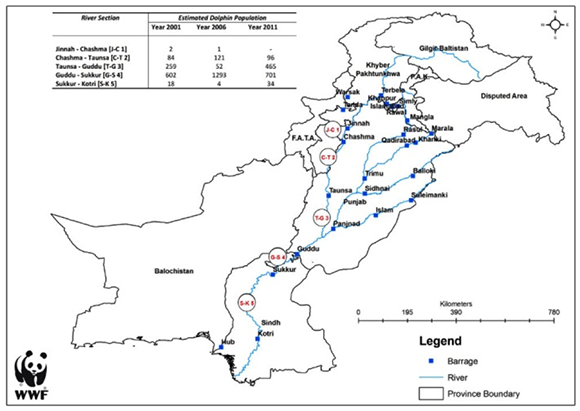Indus River Dolphin
The Indus is among the great rivers of the world. It originates from the mountains of Tibet and flows through Ladakh and Pakistan before Entering the Arabian Sea near Karachi. On its more than 3000 km journey it passes through the Himalayan and Karakoram mountain ranges, the fertile plains of the Punjab and vast desert of Sindh, encountering a rich variety of wildlife during its journey.
Among these species are resident and migratory birds, mammals, reptiles and fish, and particularly the Indus Dolphin (Plastanista minor) or Bulhan, as it is known locally. It is unique as it is blind. It is one of the most endangered cetacean species of the world. Most dolphins and whales are found only in the sea, but the Indus River Dolphin is fresh-water species. Other closely related to it fresh water blind dolphins in the Ganges, Brahmaputra and Meghna Rivers in India, Nepal and Bangladesh. China’s Yangtze River dolphin has become extinct recently. The Amazon & Orinoco Rivers in South America also have a fresh water dolphin.
What makes Dolphin Unique
The Indus River Dolphin is a very unusual kind of cetacean. It is thought to have its origin in the ancient Tethys Sea, which disappeared around fifty million years ago. This dolphin adapted to the river habitat. Living in the turbid waters of the Indus in which underwater visibility was poor, a sophisticated sonar system known as echolocation developed gradually developed, which it uses to steer and hunt. The Indus River Dolphin is a unique genome, an irreplaceable part of the biodiversity of life on earth.
How Many Indus Dolphins Remain and where they live?
It is estimated that there are between 1100 to 1400 blind dolphins remaining in Pakistan. The species is listed as “Endangered” by the World Conservation Union (IUCN).  The largest population of approximately 700 exists in the Sindh provinces between the Sukkur and Guddu Barrages. Smaller populations of 465 and 96 occur further upstream between Guddu and Taunsa and Taunsa and Chasma Barrages. Historically the Dolphin existed from the Indus estuary up into the foothills of the Himalayas at Attack. They were also found in all major Indus Tributaries, including upstream in the River Ravi. Since the construction of the Indus irrigation System, the dolphins have declined dramatically. Now they remain only in a short stretch of the main Indus River in small populations, which have been separated by impassable irrigation weirs or barrages across the Indus River. (The dolphin is now mainly confined to the range highlighted on the map).
The largest population of approximately 700 exists in the Sindh provinces between the Sukkur and Guddu Barrages. Smaller populations of 465 and 96 occur further upstream between Guddu and Taunsa and Taunsa and Chasma Barrages. Historically the Dolphin existed from the Indus estuary up into the foothills of the Himalayas at Attack. They were also found in all major Indus Tributaries, including upstream in the River Ravi. Since the construction of the Indus irrigation System, the dolphins have declined dramatically. Now they remain only in a short stretch of the main Indus River in small populations, which have been separated by impassable irrigation weirs or barrages across the Indus River. (The dolphin is now mainly confined to the range highlighted on the map).
Why it is called the Blind Indus Dolphin?
The Indus Dolphin is functionally blind. However, this is not a disadvantage but an adaption to living in a turbid river environment where eyes are virtually useless. Instead of eyesight, the dolphin had developed a high-tech echolocation or sonar system to “see” and judge its environment. Sound Pulses are emitted into the water through the “melon” or bulge at the front of the dolphin’s head. The Indus River Dolphin can navigate and locate objects using this echolocation system. What remains of its eyes are now no bigger than a Pinprick.
Mammal or Fish?
Although the Indus Dolphin looks like a fish, it is a mammal. Like humans it breathes air and gives birth to live young that feed on the mother’s milk for up to two months.
The Appearance of the Indus Dolphin:
Take a close look the Picture. When you see the Dolphins in the wild they emerge momentarily so it is often difficult to see them clearly.
 Colour: Mostly Mid gray-brown
Colour: Mostly Mid gray-brown
- Eyes: the Indus dolphin in functionally blind and has no lens in its tiny eyes.
- Teeth: adults have between 30 and 36 sharp teeth on each side of the upper and lower jaws. The teeth at the end of the rostrum are longer and protruding.
- Rostrum: River dolphins have a much longer rostrum than oceanic dolphins. It can be up to one fifth of the body length.
- Blowhole: dolphins breathe through a blowhole located on the top of their head.
- Neck: the neck is relatively narrow and very flexible which helps the dolphins move in complicated river environment.
- Flippers: Bulhans have very broad flippers which stabilize them at slow speeds in fast flowing water.
How Does the Indus Dolphin Swim?
The Indus river dolphin often swims on its side as it seems it trials flipper along the bottom of the river and moves its tails from side to side like a fish. This behavior enables it to swim in water as little as 30 cm deep. The Dolphin needs to breathe after every 60 to 160 seconds. It swims to the surface, rotates upright to take in air, and then rotates through 90 degree again as it swims back to the bottom. This Unique swimming behavior in not routinely seen in any other dolphin except the blind river dolphins.
Why is the Indus River Dolphin Endangered?
- Lack of Freshwater: Extensive irrigation schemes mean that during winter months there is very little water left in the Indus River for the Dolphin to live in.
- Drift in Irrigation Canals: sometimes dolphins drift into irrigation canals and become trapped in narrow channels where they die.
- Fish nets: Dolphins sometimes get entangled in fishing nets in the river and drown.
- Pollution: Chemicals in the Indus River such as pesticides and toxic industrial effluents. These enter the dolphin’s body and reduce their physical fitness making them more prone to illness and reproductive problems.
- Fragmented Habitat: Indus Dolphins have been split into several small populations separated by impassable barrages. The tiny populations may be too small to be viable and may suffer from inbreeding which can result in reduced fitness or physical deformities.
- Hunting: In some places dolphin oil and body parts are sold and used as traditional medicine.
Useful web links
Feedback
Contact Us
Testimonials
This website is made possible by the support of the American people through the United States Agency for International Development (USAID). The contents are the sole responsibility of Sustainable Tourism Foundation Pakistan and do not necessarily reflect the views of USAID or the United States Government.
Copyright@2015 STFP

.gif?crc=178793418)